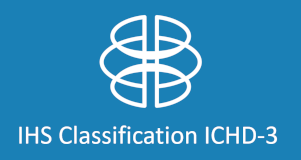2. Tension-type headache (TTH)Hartmut Gobel2019-06-17T17:36:41+00:00
Previously used terms:
Tension headache; muscle contraction headache; psychomyogenic headache; stress headache; ordinary headache; essential headache; idiopathic headache; psychogenic headache.
Coded elsewhere:
Tension-type-like headache attributed to another disorder is coded to that disorder.
General comment
Primary or secondary headache or both?
Three rules apply to tension-type-like headache, according to circumstances.
- When a new headache with the characteristics of tension-type headache occurs for the first time in close temporal relation to another disorder known to cause headache, or fulfils other criteria for causation by that disorder, the new headache is coded as a secondary headache attributed to the causative disorder.
- When pre-existing tension-type headache becomes chronic in close temporal relation to such a causative disorder, both the initial tension-type headache diagnosis and the secondary diagnosis should be given.
- When pre-existing tension-type headache is made significantly worse (usually meaning a two-fold or greater increase in frequency and/or severity) in close temporal relation to such a causative disorder, both the initial tension-type headache diagnosis and the secondary diagnosis should be given, provided that there is good evidence that the disorder can cause headache.
In the case of chronic tension-type headache in association with medication overuse, a close temporal relation is often difficult to establish. Both diagnoses, 2.3 Chronic tension-type headache and 8.2 Medication-overuse headache, should therefore be given in all such cases.
Introduction
Tension-type headache is very common, with a lifetime prevalence in the general population ranging in different studies between 30% and 78%. It has a high socio-economic impact.
While it was previously considered to be primarily psychogenic, a number of studies since ICHD-I strongly suggest a neurobiological basis to 2. Tension-type headache, at least for its more severe subtypes.
The division of 2. Tension-type headache into episodic and chronic types, introduced in ICHD-I, has proved extremely useful. In ICHD-II, the episodic type was further divided into an infrequent type, with headache episodes less than once per month, and a frequent type. 2.2 Frequent episodic tension-type headache can be associated with considerable disability, and sometimes warrants treatment with expensive drugs. In contrast, 2.1 Infrequent episodic tension-type headache, which occurs in almost the entire population, usually has very little impact on the individual and, in most instances, requires no attention from the medical profession. The distinction of 2.1 Infrequent episodic tension-type headache from 2.2 Frequent episodic tension-type headache thus separates individuals who typically do not require medical management, and avoids categorizing almost the entire population as having a significant headache disorder, yet allows their headaches to be classified. 2.3 Chronic tension-type headache is a serious disease, causing greatly decreased quality of life and high disability.
The exact mechanisms of 2. Tension-type headache are not known. Peripheral pain mechanisms are most likely to play a role in 2.1 Infrequent episodic tension-type headache and 2.2 Frequent episodic tension-type headache, whereas central pain mechanisms play a more important role in 2.3 Chronic tension-type headache. Increased pericranial tenderness is the most significant abnormal finding in patients with any type of 2. Tension-type headache: it is typically present interictally, is exacerbated during actual headache and increases with the intensity and frequency of headaches. Increased tenderness is very probably of pathophysiological importance. ICHD-II therefore distingushed patients with and without such disorder of the pericranial muscles, a subdivision maintained in ICHD-3 to stimulate further research in this area.
Pericranial tenderness is easily detected and recorded by manual palpation. Small rotating movements with the index and middle fingers, and firm pressure (preferably aided by use of a palpometer), provide local tenderness scores of 0-3 for frontal, temporal, masseter, pterygoid, sternocleidomastoid, splenius and trapezius muscles. These can be summed to yield a total tenderness score for each patient. These measures are a useful guide for treatment, and add value and credibility to explanations given to the patient.
The diagnostic difficulty most often encountered among the primary headache disorders is in discriminating between 2. Tension-type headache and mild forms of 1.1 Migraine without aura. This is more so because patients with frequent headaches often suffer from both disorders. Stricter diagnostic criteria have been suggested for 2. Tension-type headache in the hope of excluding migraine that phenotypically resembles tension-type headache. Such criteria were proposed in the Appendix of ICHD-II as A2. Tension-type headache. However, the increase in specificity of the criteria reduces their sensitivity, resulting in larger proportions of patients whose headaches can be classified only as 2.4 Probable tension-type headache or 1.5 Probable migraine. With still no evidence that such a change would be beneficial, these stricter diagnostic criteria remain in the Appendix, for research purposes only. The Classification Committee recommends comparisons between patients diagnosed according to each set of criteria, not only for characterization of clinical features but also for enquiry into pathophysiological mechanisms and response to treatments.
